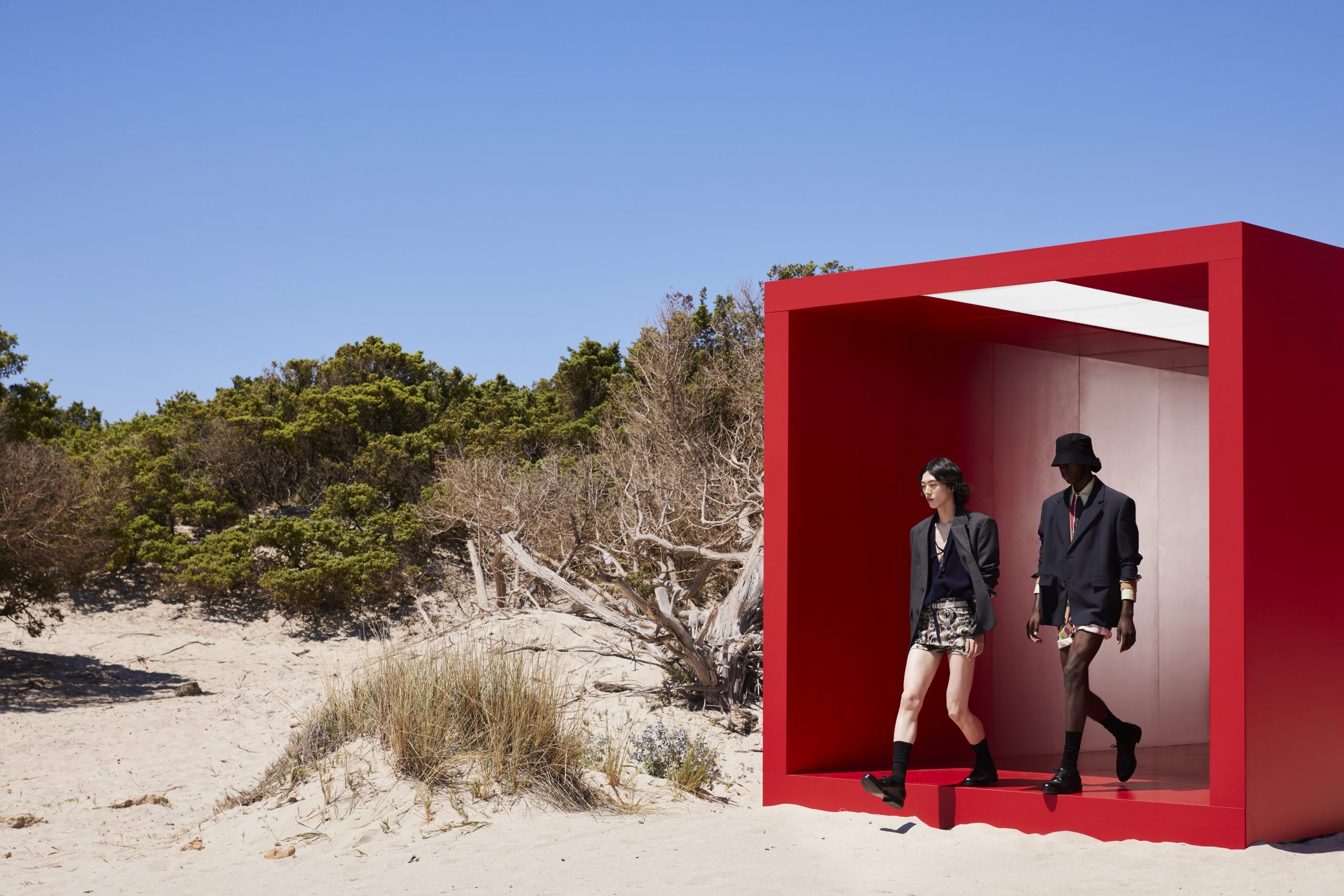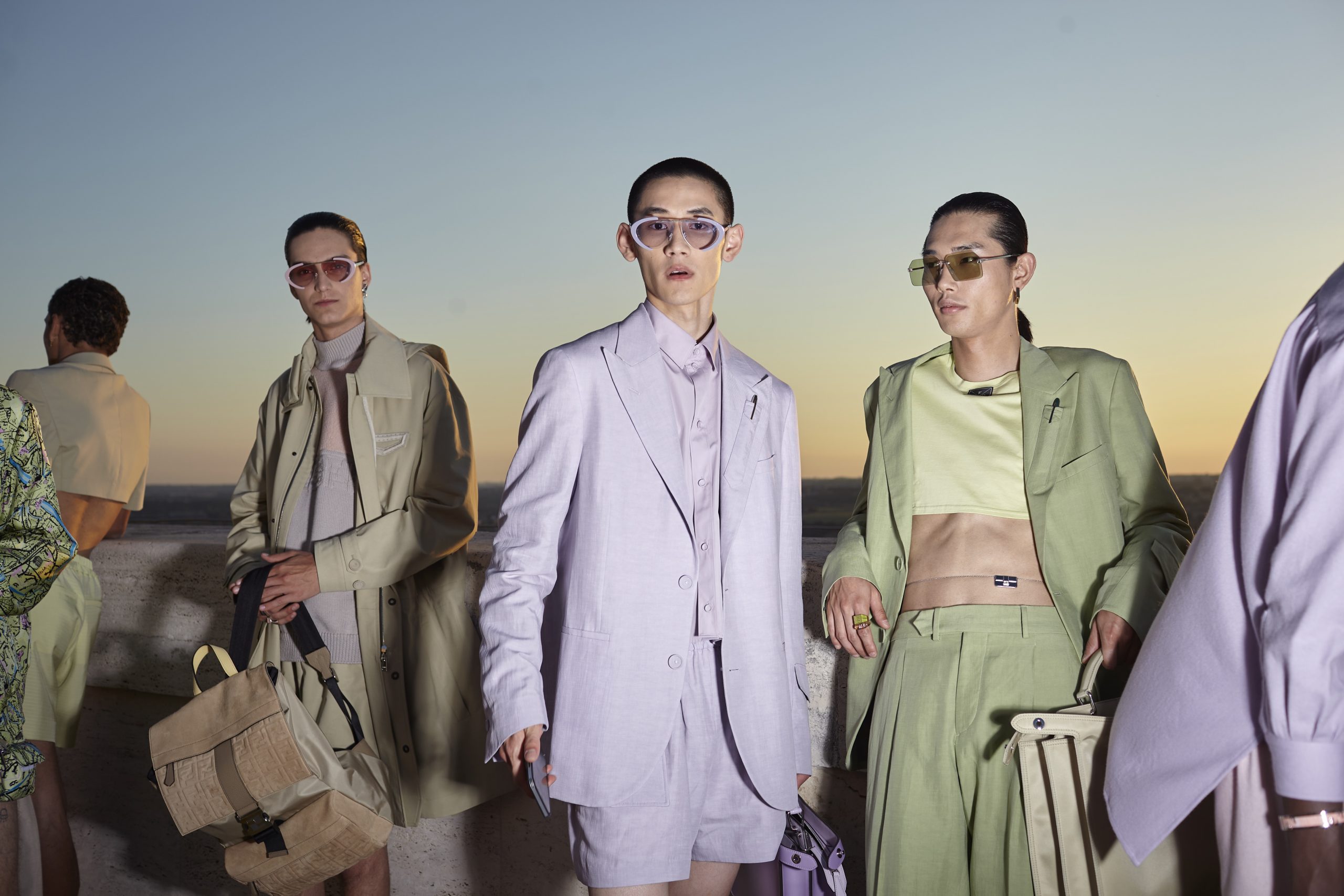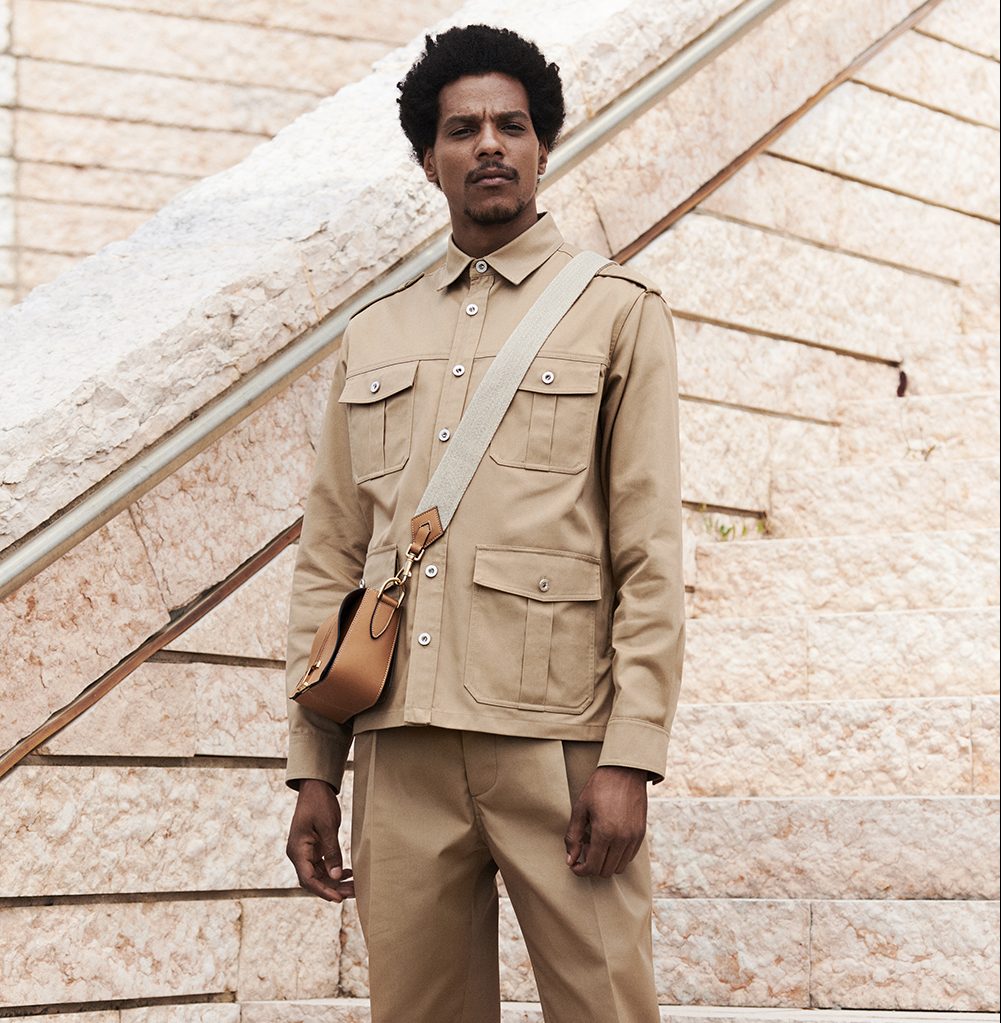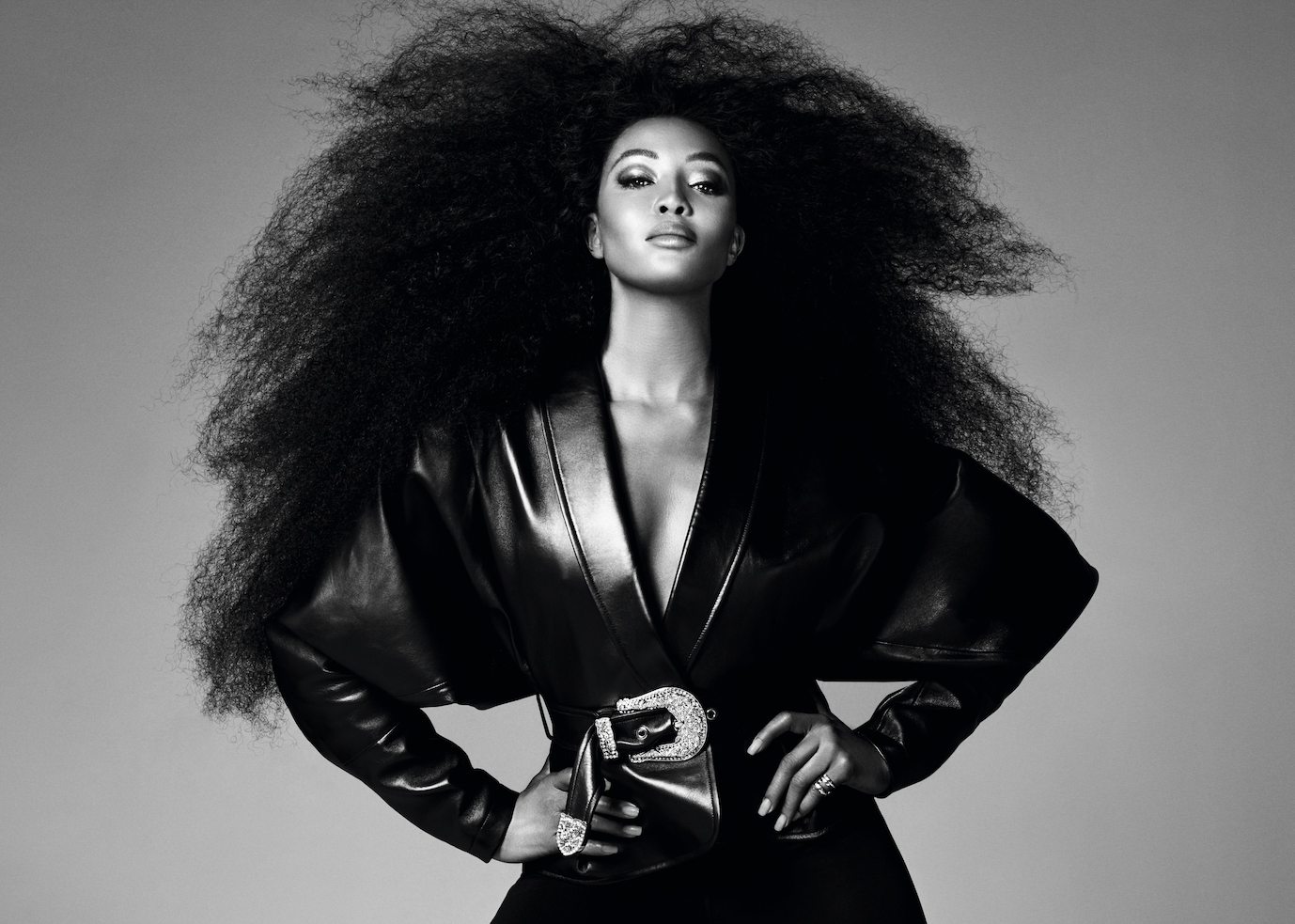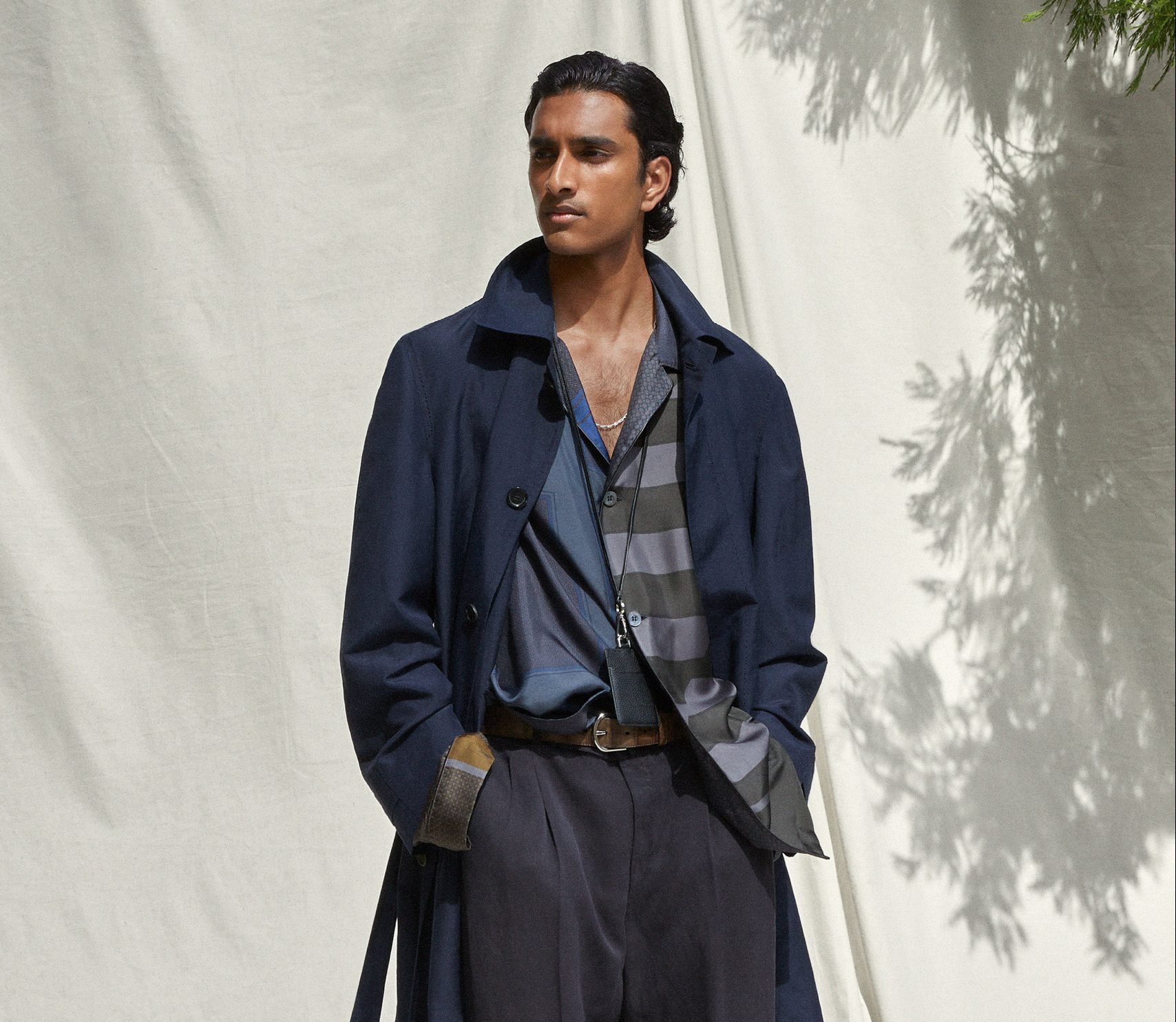
Inside Milan Fashion Week
More skin, loose-fits and added elegance from Brioni, Prada, Fendi, Zegna and more.
Related articles
Brioni
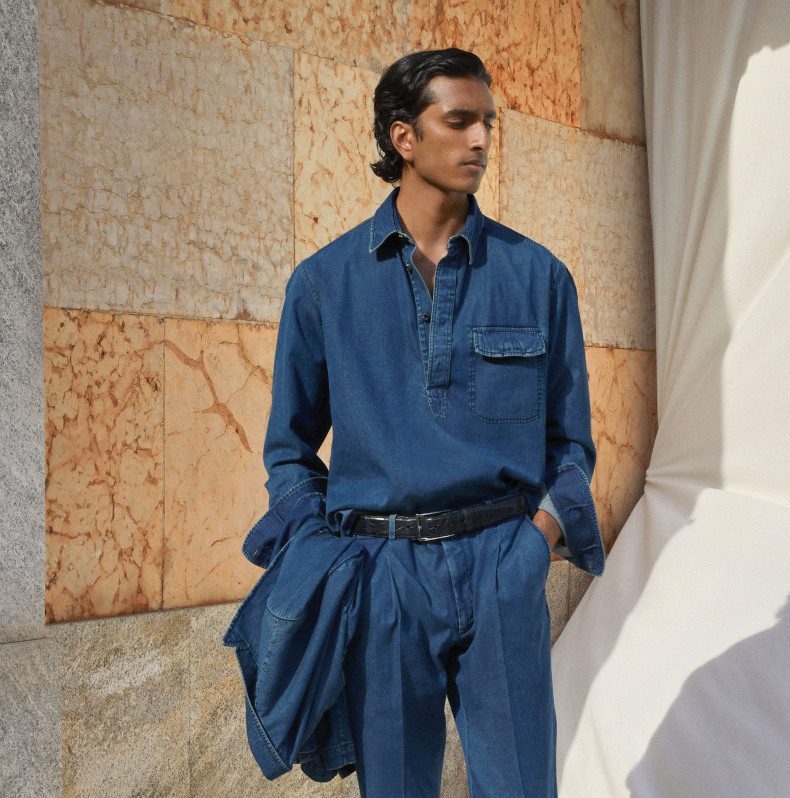
“The softness puts the wearer in a good mood, and I want the clothes to bring out the personality, without overpowering the individual or shouting designer label,’” Brioni’s design director Norbert Stumpfl said about the spring collection, which was made with the most sophisticated materials. A trained tailor himself, Stumpfl highlighted the craftsmanship of Brioni’s artisans, who succeeded in creating a lineup that had a nonchalant and relaxed attitude, for men “who don’t spend too much time in front of the mirror.”
The designer underscored the importance of lightness, emphasized by the fabrics, which ranged from blends of linen, cashmere and silk to Sea Island cotton and double-layered knitwear crafted from Escorial wool, cashmere and silk blend. A trench in nubuck was treated to be water-resistant. Shapes were looser as the designer wants the Brioni man to be comfortable — and cool, too, hence the linen sleeves on a suede jacket, all finished by hand. A jacket was made from the same nylon used for women’s hosiery, which makes it extremely light, a quarter of the weight of a regular jacket, said the designer.
Stumpfl also created pyjama-style shirts and pants crafted from unused samples of silk necktie fabrics which are re-dyed, so that each piece is unique. Brioni’s eveningwear was stunning as the designer presented the Veronese jacket crafted from a brocade hand-woven on a late 19th-century jacquard loom, in a process that takes five months from start to finish. It’s clearly a garment for those in the know — and with deep pockets — as the floral embroideries are made with gold and silver threads, bumping up the retail price to 50,000 euros. Another showstopper was a dinner jacket in faille ombré silk carefully dyed by hand using 50 shades of black and greys with an iridescent effect in a “workintense” technique that Stumpfl said had “not been used since the times of Christian Lacroix and Roberto Capucci.” Further pointing to Brioni’s craftsmanship, the brand also introduced silver jewellery hammered by hand. — Luisa Zargani
Prada
Miuccia Prada and Raf Simons, intellectual designers both, have come up with a clever response to these turbulent times: simplicity, joy and the human touch. Their codesigned spring 2022 collection had a light spirit, and it felt honest and effortless, while still brimming with that edgy coolness that is quintessentially Prada. “The world is so complicated — so overcomplicated — we can lose the essence of human life,” Prada said in the notes sent to reviewers after the show. “This is an idea I have been interested in for a number of seasons, and which we have been exploring in different ways. We come from previous collections that were all about technicality, machines, that reflect the necessity of technology. Now, we are thinking of the opposite. Human, real. Our interest in technology came from its place as a communication tool for humanity. But this expression is much more direct.”
According to Prada, the collection was very much about portraying the joy of the everyday. “The notion that living your life can be a euphoric experience,” she continued. “Much joy can come out of something so simple: when times are complicated, we are searching for simple, direct joys. An innocence.” What’s more innocent than childhood? Cue the key item of the season, the romper, shown with rolled-up cuffs and presented in different variations, from solid options to printed designs, including a couple featuring irregular vertical stripes. The collection’s summer vibe was amplified by the video, which combined the concept of human artifacts and nature.
A red tunnel installed inside a warehouse at the Fondazione Prada in Milan, became a portal to the natural environment, leading to the sandy beaches and crystal clear water of Sardinia. “The show represents a transition — between a tunnel, an urban space and the sea. We don’t feel it should be complicated — the story is pure, direct. A move from indoors to outdoors. After constriction, the power of that feeling of infinity, an endless horizon. It gives you the feeling of freedom again. It’s human nature,” Simons said. “What we are interested in is: How can these two moments, these two environments, fuse together? A contrast between the system of the fashion industry — the runway — and nature.
We started in the previous autumn show to introduce these moments of different behaviour from the cast, and here, you see the models in another context, another environment, a different reality. You see them be totally free, in reality. It’s natural.” The collection fell somewhere between fashion utopia and everyday reality. Unfussy silhouettes were repeated across the lineup, adapting to the urban or beach environment. For example, the romper became a metropolitan uniform in a dark navy version styled with polished brogues, or exuded a carefree chic vibe when rendered in a white cotton printed with sea motifs, including anchors, and layered under a boat-neck sweater with crisscross details.
The precise outerwear, spanning from minimal trenches and car coats in joyful colours to leather jackets with a lived-in look, anchored the lineup in an elevated, everyday practicality. Elsewhere, tank tops with squared necklines were matched with relaxed pants, while charming hoodies in surfer prints were paired with rolled-up short pants. While Prada and Simons focused on simplicity and timelessness, there was plenty for hype beasts. The short shorts that resembled miniskirts, the bucket hats with the triangle pouch on the back brim, and the striped knits with a naif-like look were all items that will influence the season, at a both creative and commercial level. — Alessandra Turra
Ermenegildo Zegna
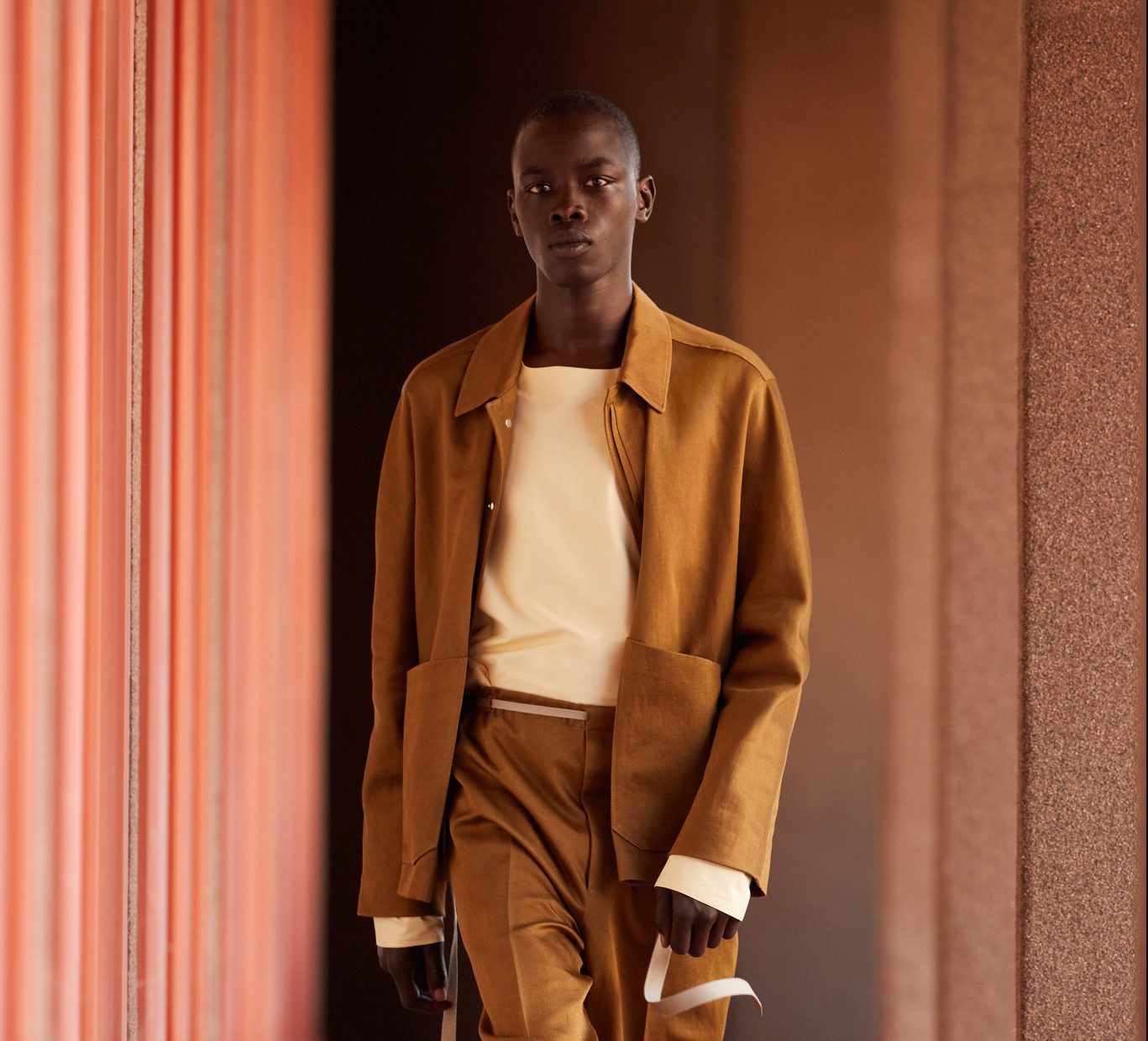
What can digital add to the experience of the physical show? Storytelling, according to Ermenegildo Zegna artistic director Alessandro Sartori. While the company expects to return to the live format in January, the designer thinks that digital will continue to play a key role to reach a wider audience and share the story behind the clothes. For Sartori, the pandemic didn’t only showcase the power of digital, but strongly accelerated a process of transformation in consumers’ approach to fashion. “I think we are going through a very exciting moment, where we are radically changing the way we design and sell the collections,” said Sartori.
While he thinks that classic formalwear will continue to be relevant in the luxury world of bespoke and customisation, ready-to-wear has to adopt to meet the new needs of today’s consumers. His spring 2022 collection pointed to a new path for the brand, and Sartori questioned the traditional idea of suiting. “The suit now becomes a combination of separates,” he said, explaining that the brand will now give retailers and consumers the chance to create their own suit combining pants with a range of matching tops. This new approach to suiting was the main theme of the beautiful video that the company created to present its latest collection.
Filmed in different locations across Italy, the video showed models running across a labyrinth in the huge park surrounding the castle of Masino in Piedmont and then they are suddenly catapulted into a more industrial space where they walk down the stairs of the new building of Milan’s IULM university. The distinctive architecture of the Monte Amiata housing complex in another Milanese district, which was built by Carlo Aymonino and Aldo Rossi in the late ‘60s, offered another impressive backdrop for the runway show that ended with a waterside dinner in the Rho Fiera area. Fashion-wise, the collection felt like an ode to comfortable elegance with a relevant cool factor.
Utility uniforms from the 1940s and 1950s served as starting point for the lineup’s overall spirit, merging urban sophistication with practical functionality. Baggy or slightly roomy pants were paired with boxy jackets with kimono sleeves. They featured a range of details, including straps and inside buttons to allow multiple fits. Over shirts, rendered in a wide selection of materials, from linen and stretch knit to supple leather, stood out, as did charming sweaters with 3D effects.
The overall sense of lightness and relaxed elegance was heightened by the delicate pastels, such as lilac and pistachio green, alongside refined neutrals, including tobacco brown, blue and military green. Softness and comfort also defined the accessories. Bags with multiple pockets were crafted from kangaroo leather, that was also used for padded chunky loafers and slip-ons with elastic inserts. With this collection, the Ermenegildo Zegna brand made a bold statement, in tune with the times and its legacy of textile experimentation and elegant dressing – Alessandra Turra.
Fendi
In a world that necessarily got much smaller for all us, Silvia Venturini Fendi found inspiration in her work environment. “I strongly believe that what is close and familiar can be as much as inspiring as what is far and exotic,” she said during a preview on the set of the short movie by artist Nico Vascellari that portrays the Fendi’s men’s spring 2022 collection. Palazzo Della Civiltà Italiana, that houses Fendi’s headquarters in Rome, served as the grand set for the video. It also offered Venturini Fendi the privileged point of observation on the Eternal City that deeply influenced the creation of her latest collection.
Looking at her native city from the top of the palazzo, one of the tallest buildings in Rome, she started thinking about proportions and perspectives, that, along with a study of the changing colours of the Roman sky across the different seasons, became the focal points of her beautiful lineup. While sticking to uncomplicated clothes that reflect the needs of the real life, the designer developed an exciting wardrobe that was luxurious, but also light and playful.
Colours played a key role. Neutrals were juxtaposed with lemon yellow, lime, ice blue, lilac, pistachio green and peony pink, sometimes mixed and matched on abstract patterns. A sense of adventure and exploration, combined with practical functionality, informed the lightweight, precise outerwear, the suede over shirts and the short pants featuring multiple patch pockets. Trenches dabbed with leather and jacquard denim jackets were roomy, while Fendi’s new, fun suit for the season featured pants and shorts with elastic waistbands matched with cropped double breasted boxy jackets.
They added a touch of fun and fashion frivolity to the collection, as did the adorable accessories, spanning from bags cut in the shape of bucket hats, Plexiglas mini Baguettes, table tennis rackets case holder and swimming goggles developed in collaboration with specialist Arena. Putting the accent on her top view, Venturini Fendi also splashed a range of pieces, including a languid silk pyjama set, with an archival maps of Rome, and abstract patterns inspired by the views of the globe from space. The short film depicted the models walking by the arches and on the rooftop of the Palazzo Della Civiltà Italiana hit by the light of the Roman sun at the different hours of the day and ends with the Fendi fashion parade taking over the facade of the palazzo at night. A woman designing for men, Silvia Venturini Fendi gave her clothes a practical romanticism and a graceful attitude. — Alessandra Turra
Etro
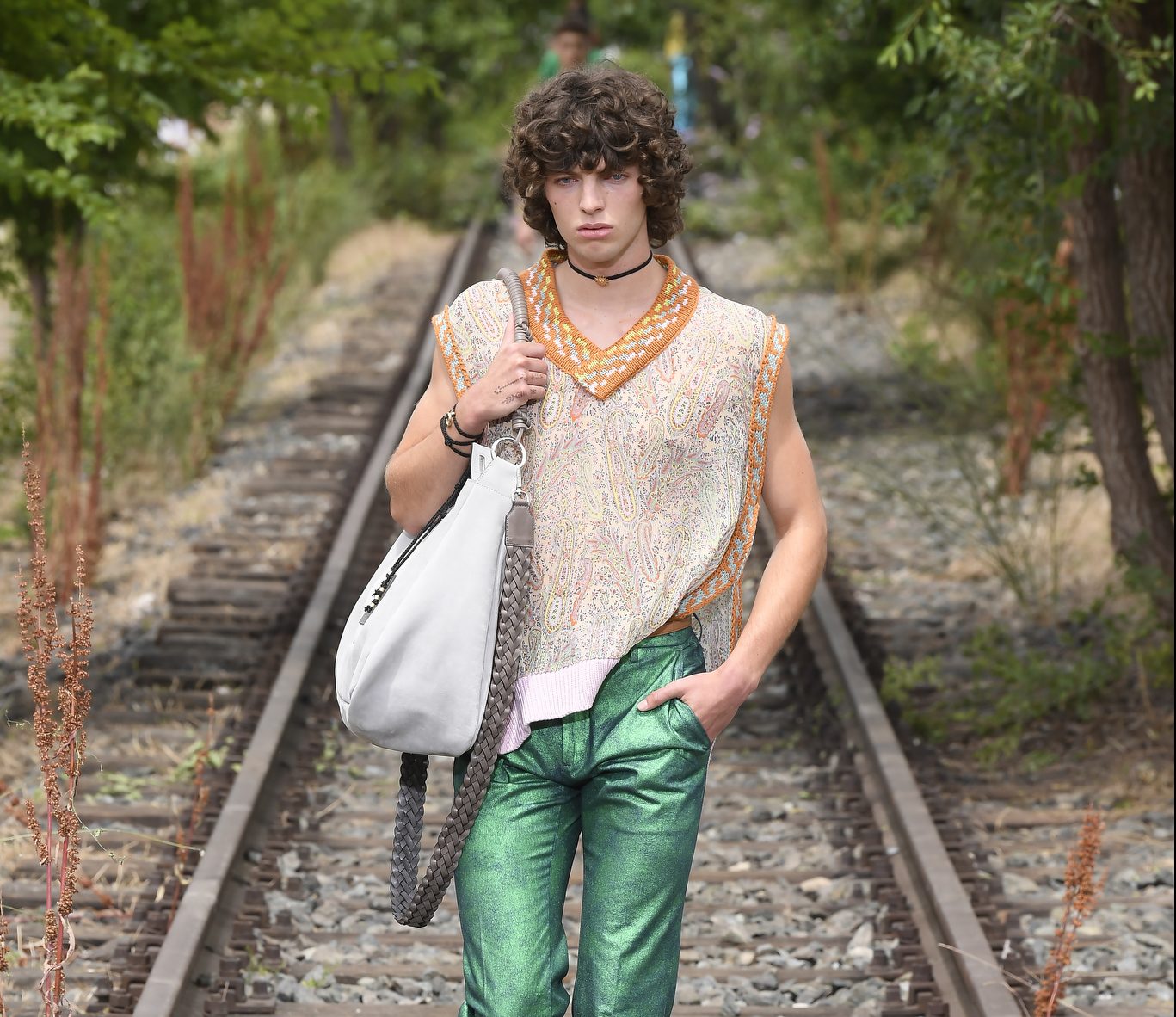
With his spring 2022 collection, Kean Etro paid tribute to the Italian musician and artist Franco Battiato, who died last month. For his lyrics, often containing culturally exotic, philosophical and religious references, Battiato was nicknamed Il Maestro, and he deeply influenced Etro’s own vision and life since their first meeting back in 1985. To the soundtrack of Battiato’s music, Etro’s men’s wear creative director unveiled the collection at Milan’s former railway station Scalo Farini — one of the three live shows in Milan this season. Models walked on the train tracks in the open air, which seemed to Etro “to have no beginning and no end,” surrounded by wildflowers, which all contributed to the sense of freedom and joy the collection telegraphed. The tracks were an additional reference to globetrotting — always an inspiration for the designer.
This time, Etro wanted to “explore the nomadic spirit.” (Incidentally, “Nomadi” is also a 1988 song written by Battiato.) To further convey the idea of wanderlust, the designer also cited travel writer Bruce Chatwin and Agatha Christie, not for her detective novels, but rather for her trips accompanying her husband, archaeologist Sir Max Mallowan, on his excavations in the Middle East. Etro’s inspiration, however, was not literal — no cargo pants or trekking shoes in sight. Instead, Etro’s collection was all about offhand fluidity and colours that transmit “energy and optimism.” To wit, the first part of the show hinged on modern suits, silk shirts and Bermuda shorts in bright orange, yellow, fuchsia and metallic green — at times tie-dyed.
Models paraded in silk cadi caftans, knitted vests with silk georgette inserts and fil coupé shirts lit up by golden threads. The brand’s unmistakable paisley prints alternated with archival patterns on silk pyjamas. Earthy colours infused the second part of the collection, on bombers and shirts embellished with patterns inspired by petroglyphs, or rock carvings, but these were not literal, either. “I wanted clean and graphic symbols, as if they were memories of the past,” Etro said. He paid attention to the accessories, too, ranging from colourful and functional pouches and cool sneakers to large and soft backpacks and saddlebags in washed leather. The collection had a rock ‘n roll vibe running throughout — after all, Etro has been dressing the winners of the Eurovision music contest, Italian rock band Måneskin. — L.Z.
MSGM
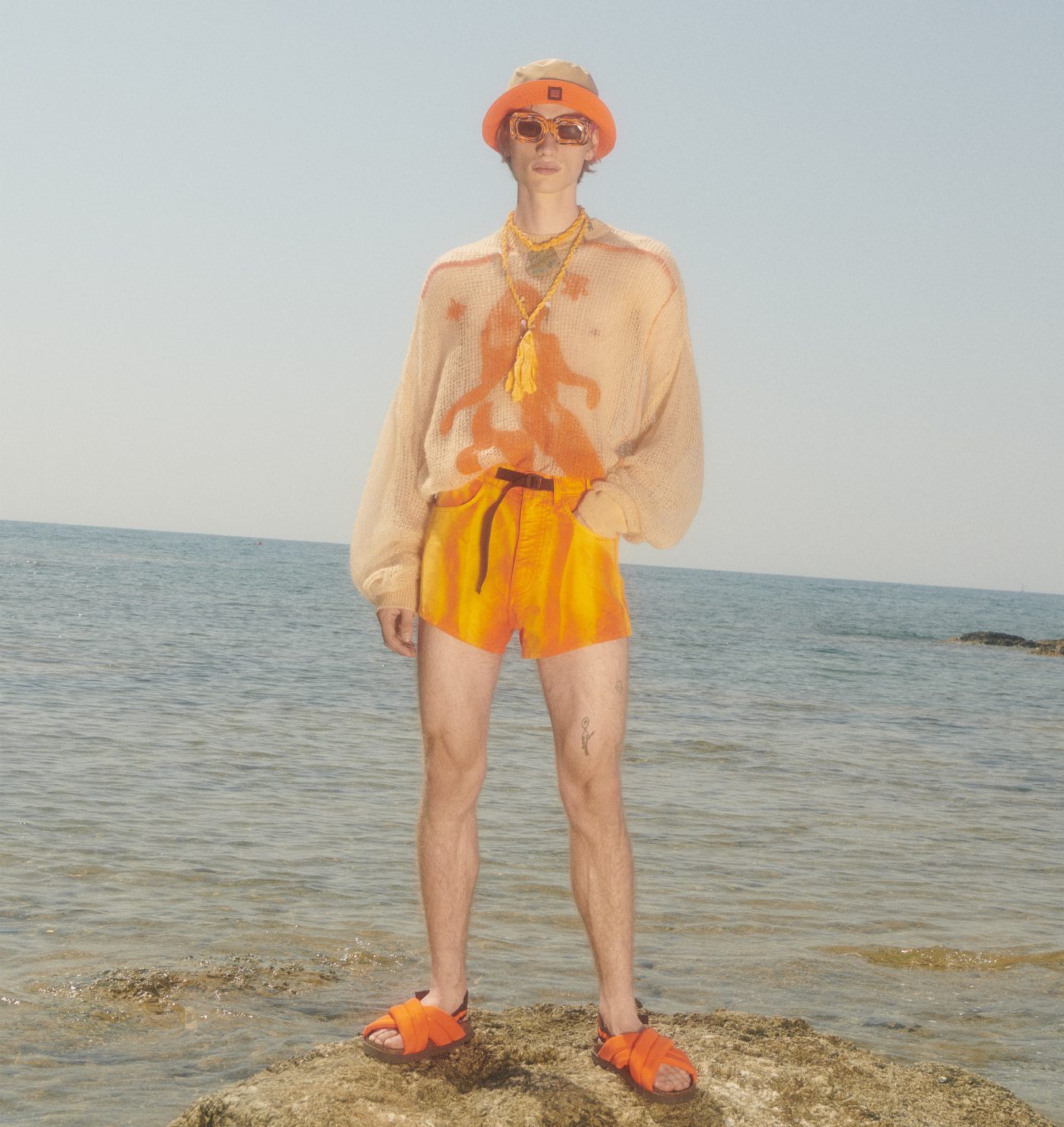
Once again, Massimo Giorgetti proved that he understands youths and their codes like no other. For spring 2022, he channelled their desire for freedom in a poetic fashion film evoking the sun-drenched atmosphere in the photography of San Diego-based artist Stephen Milner. Cantered on a group of boys spending a day at the seaside, the short movie showcased a more contemplative mood compared to MSGM previous digital presentations. “I noticed there’s this desire to reveal the skin but not in a sexy way, rather more delicately, with romanticism,” Giorgetti explained. Connection with nature played a big role in the fun and spirited collection. Literally, the underwater theme — which charmed also Prada’s co-creative directors Miuccia Prada and Raf Simons this season — informed the bold prints splashed on the garments. An artisanal feel ran through a charming intarsia cardigan with shell motifs, a mohair sweater depicting a mermaid and structured sweatshirts handwoven using strips of recycled organic cotton. (Attention to recycled fibres and natural techniques was heightened throughout the range.) The ‘90s-inspired range included workwear jackets and cargo pants dyed naturally for a watercolour-like effect. Sharks motifs and prints of crabs and shells outlined with piercings popped up on knitwear, raw-cut hoodies and bowling shirts. Pastel tones with energizing orange and vibrant green gave everything a joyful zing. Sport references, including wetsuit tops and leggings, nodded to the Californian surf scene portrayed in Milner’s images and punctuated another fresh and cool collection from MSGM. — Sandra Salibian
Tod’s
Tod’s creative director Walter Chiapponi can’t wait to return to a physical show, but once again found a way to present his collection with a video that in sync with his sensibility and the brand spirit. He chose to portray an eclectic and diverse group of young men — actors Saul Nanni and Meledeen Yacoubi, musician Lorenzo Sutto, singer Theo Isambourg and model Yonghong — enjoying a day in the sun at the Petra vineyard in Suvereto, Tuscany. The striking and avant-garde design of the building by Swiss architect Mario Botta is a recognizable landmark in the country and Chiapponi said he was seeking “a place immersed in nature with a modern architecture.” That it is, with its sectioned cylinder in pink travertine and a stairway running the height of the hill in the Maremma countryside.
Inspired by the adventurous images of artist Peter Beard, Chiapponi delivered a collection that was more nonchalant than usual, with a touch of sensuality. Chiapponi made a statement with the new canvas Jack Biker jacket with leather gommino pads — the brand’s signature pebble motif — as patches on the elbows. Developing an urban safari theme, the designer offered canvas shirts or field jackets worn over Bermuda shorts; quilted jackets; nylon shorts; suede hoodies and a shirt jacket with contrasting patch pockets in leather — a signature material for Tod’s.
There were trenchcoats in light nylon in bright hues and soft chambray trousers. Chiapponi mixed different checkered patterns on cotton gauze shirts and jackets. All garments were light and deconstructed as the practical pants in parachute canvas with drawstrings at the ankle. With John F. Kennedy Jr. as another inspiration, it’s obvious that Chiapponi never strays from elegant and sophisticated designs, even when he veers toward more casual looks. Accessories, always key for Tod’s, were strong, ranging from the new Dots Run sneakers in nylon and leather in contrasting colours with expanded gomminos on the soles, to camera bags and soft, ruched moccasins. An expanded lion head appeared on several items as a crest. — Luisa Zargani
Brunello Cucinelli
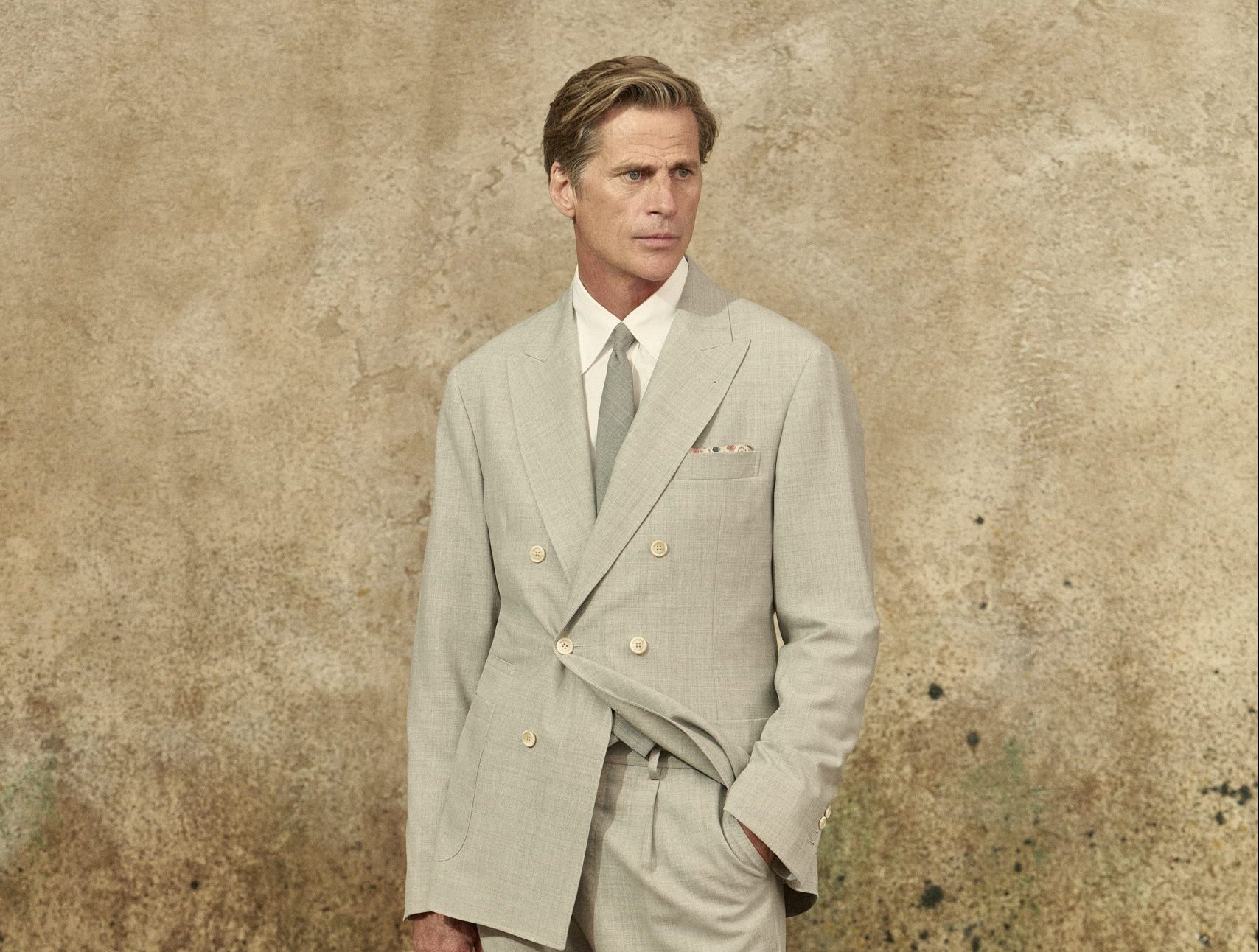
Brunello Cucinelli’s take on things is generally an upbeat and optimistic one. This was once again the case on Saturday, when he spoke of rebirth after the pandemic, which is leading men to rediscover a taste for elegance and dressing well. As a consequence, at the physical presentation at Cucinelli’s headquarters in Milan, there was a strong focus on the suit, “synonymous of elegance, but not the Wall Street kind of business suit” of yore. The fit must be “relaxed and contemporary,” he noted. Case in point, the traditional pinstriped suit was revisited with more understated, almost faded patterns; deconstructed jackets, and feather-light natural fabrics.
The fabrics were also practical, such as Tasmanian wool, which allows for high performance without wrinkling, he noted. Blends of linen, wool and silk contributed to the summery ease of the suits. Cuffed ankle pants with front pleats were slightly longer than in previous styles. Adding a sportier touch, Cucinelli showed cargo pants, either short — Bermuda style — or elasticized at the ankle. Mismatched blazers also contributed to the easy style as did the range of soft unlined suede bombers, which were also presented with lasered chevron patterns or quilting motifs. The palette was neutral, with delicate pastels, from yellows, pinks to azure, alternated with a range of greys, off-white and panama or sand. Jeans were shown in the traditional indigo hue — among the bestselling pants for the company, Cucinelli said. “Simplicity in Elegance,” summed up the brand’s look book, but the former at Cucinelli is achieved through skilled craftsmanship and extensive research and development of fabrics. — L.Z.
Canali

A fuchsia suit worn with a plain white T-shirt was unexpected but stood out in its simplicity in the Canali spring 2022 collection, which was filled with relaxed silhouettes and lightweight fabrics. The Italian brand showcased the Canali 1934, Exclusive and Black Edition lines, underscoring to the label’s versatility in catering different customers and demands beyond its roots in tailoring. “The pandemic accelerated a trend that was already present: The need to break the rigid schemes that separate formalwear from the informal one.
Fusing these two dimensions enables customers to easily mix and match the pieces,” said the company’s president and chief executive officer Stefano Canali, explaining that, overall, the collection was inspired by the natural landscape in Los Angeles and 1990s cinema. Neutral tones dominated the Canali 1934 line, which focused on reinterpretations of the trucker jacket — including a white denim version with geometric tobacco suede pockets and a chic aquamarine suede option — as well as on knitwear, often styled with pleated pants. The laid-back attitude took a bolder turn in the Black Edition line, with vibrant suits and a bowling shirt splashed with floral prints.
Sportier garments such as a black anorak and a hooded jacket with black and-white graffiti graphics veered toward a more functional and urban direction that was a stretch compared to the rest of the collection. Although these two lines made for eye-catching items, the Exclusive section best exemplified the Canali ethos and the effortless mood it wanted to convey this season, thanks to pieces such as a taupe buckskin blazer and a green suede jacket with details in napa leather. Among the three souls of the collection, this was definitely the most authentic and truthful to the brand’s signature elegance. — Sandra Salibian
Originally published by WWD.
Subscribe to the Newsletter
Recommended for you
Ode to Oasi
Ermenegildo Zegna wrote the book on dapper Italian style. Now, a new coffee-table tome pays homage to its greatest creation—one that, hopefully, will endure long after the brand is gone.
By Brad Nash
June 25, 2024
Everybody Loves Naomi
Fashion fans adore her. And so do we. Lucky, then, that a new exhibition is paying homage to the undisputed queen of the catwalk.
By Joseph Tenni
June 22, 2024
You may also like.
By Josh Bozin
24/07/2024
You may also like.
5 Lounge Chairs That Add Chic Seating to Your Space
Daybeds, the most relaxed of seating solutions, offer a surprising amount of utility.
Chaise longue, daybed, recamier, duchesse brisée—elongated furniture designed for relaxing has a roster of fancy names. While the French royal court of Louis XIV brought such pieces to prominence in fashionable European homes, the general idea has been around far longer: The Egyptian pharaohs were big fans, while daybeds from China’s Ming dynasty spurred all those Hollywood Regency fretwork pieces that still populate Palm Beach living rooms. Even Mies van der Rohe, one of design’s modernist icons, got into the lounge game with his Barcelona couch, a study of line and form that holds up today.
But don’t get caught up in who invented them, or what to call them. Instead, consider their versatility: Backless models are ideal in front of large expanses of glass (imagine lazing on one with an ocean view) or at the foot of a bed, while more structured pieces can transform any corner into a cozy reading nook. Daybeds may be inextricably linked to relaxation, but from a design perspective, they put in serious work.

Emmy, Egg Collective
In designing the Emmy chaise, the Egg Collective trio of Stephanie Beamer, Crystal Ellis and Hillary Petrie, who met as students at Washington University in St. Louis, aimed for versatility. Indeed, the tailored chaise looks equally at home in a glass skyscraper as it does in a turn-of-the-century town house. Combining the elegance of a smooth, solid oak or walnut frame with the comfort of bolsters and cushioned upholstery or leather, it works just as well against a wall or at the heart of a room. From around $7,015; Eggcollective.com
 Plum, Michael Robbins
Plum, Michael Robbins
Woodworker Michael Robbins is the quintessential artisan from New York State’s Hudson Valley in that both his materials and methods pay homage to the area. In fact, he describes his style as “honest, playful, elegant and reflective of the aesthetic of the Hudson Valley surroundings”. Robbins crafts his furniture by hand but allows the wood he uses to help guide the look of a piece. (The studio offers eight standard finishes.) The Plum daybed, brought to life at Robbins’s workshop, exhibits his signature modern rusticity injected with a hint of whimsy thanks to the simplicity of its geometric forms. Around $4,275; MichaelRobbins.com

Kimani, Reda Amalou Design
French architect and designer Reda Amalou acknowledges the challenge of creating standout seating given the number of iconic 20th-century examples already in existence. Still, he persists—and prevails. The Kimani, a bent slash of a daybed in a limited edition of eight pieces, makes a forceful statement. Its leather cushion features a rolled headrest and rhythmic channel stitching reminiscent of that found on the seats of ’70s cars; visually, these elements anchor the slender silhouette atop a patinated bronze base with a sure-handed single line. The result: a seamless contour for the body. Around $33,530; RedaAmalou
Dune, Workshop/APD
From a firm known for crafting subtle but luxurious architecture and interiors, Workshop/APD’s debut furniture collection is on point. Among its offerings is the leather-wrapped Dune daybed. With classical and Art Deco influences, its cylindrical bolsters are a tactile celebration, and the peek of the curved satin-brass base makes for a sensual surprise. Associate principal Andrew Kline notes that the daybed adeptly bridges two seating areas in a roomy living space or can sit, bench-style, at the foot of a bed. From $13,040; Workshop/ APD
Sherazade, Edra
Designed by Francesco Binfaré, this sculptural, minimalist daybed—inspired by the rugs used by Eastern civilizations—allows for complete relaxation. Strength combined with comfort is the name of the game here. The Sherazade’s structure is made from light but sturdy honeycomb wood, while next-gen Gellyfoam and synthetic wadding aid repose. True to Edra’s amorphous design codes, it can switch configurations depending on the user’s mood or needs; for example, the accompanying extra pillows—one rectangular and one cylinder shaped— interchange to become armrests or backrests. From $32,900; Edra
You may also like.
By Josh Bozin
24/07/2024
22/07/2024
Watches & Wonders 2024 Showcase: Hermès
We head to Geneva for the Watches & Wonders exhibition; a week-long horological blockbuster featuring the hottest new drops, and no shortage of hype.
With Watches & Wonders 2024 well and truly behind us, we review some of the novelties Hermès presented at this year’s event.
—
HERMÈS

Moving away from the block colours and sporty aesthetic that has defined Hermès watches in recent years, the biggest news from the French luxury goods company at Watches & Wonders came with the unveiling of its newest collection, the Hermès Cut.
It flaunts a round bezel, but the case middle is nearer to a tonneau shape—a relatively simple design that, despite attracting flak from some watch aficionados, works. While marketed as a “women’s watch”, the Cut has universal appeal thanks to its elegant package and proportions. It moves away from the Maison’s penchant for a style-first product; it’s a watch that tells the time, not a fashion accessory with the ability to tell the time.
Hermès gets the proportions just right thanks to a satin-brushed and polished 36 mm case, PVD-treated Arabic numerals, and clean-cut edges that further accentuate its character. One of the key design elements is the positioning of the crown, boldly sitting at half-past one and embellished with a lacquered or engraved “H”, clearly stamping its originality. The watch is powered by a Hermès Manufacture movement H1912, revealed through its sapphire crystal caseback. In addition to its seamlessly integrated and easy-wearing metal bracelet, the Cut also comes with the option for a range of coloured rubber straps. Together with its clever interchangeable system, it’s a cinch to swap out its look.
It will be interesting to see how the Hermès Cut fares in coming months, particularly as it tries to establish its own identity separate from the more aggressive, but widely popular, Ho8 collection. Either way, the company is now a serious part of the dialogue around the concept of time.
—
Read more about this year’s Watches & Wonders exhibition at robbreport.com.au
You may also like.
22/07/2024
Living La Vida Lagerfeld
The world remembers him for fashion. But as a new tome reveals, the iconoclastic designer is defined as much by extravagant, often fantastical, homes as he is clothes.
“Lives, like novels, are made up of chapters”, the world-renowned bibliophile, Karl Lagerfeld, once observed.
Were a psychological-style novel ever to be written about Karl Lagerfeld’s life, it would no doubt give less narrative weight to the story of his reinvigoration of staid fashion houses like Chloe, Fendi and Chanel than to the underpinning leitmotif of the designer’s constant reinvention of himself.
In a lifetime spanning two centuries, Lagerfeld made and dropped an ever-changing parade of close friends, muses, collaborators and ambiguous lovers, as easily as he changed his clothes, his furniture… even his body. Each chapter of this book would be set against the backdrop of one of his series of apartments, houses and villas, whose often wildly divergent but always ultra-luxurious décor reflected the ever-evolving personas of this compulsively public but ultimately enigmatic man.
With the publication of Karl Lagerfeld: A Life in Houses these wildly disparate but always exquisite interiors are presented for the first time together as a chronological body of work. The book indeed serves as a kind of visual novel, documenting the domestic dreamscapes in which the iconic designer played out his many lives, while also making a strong case that Lagerfeld’s impact on contemporary interior design is just as important, if not more so, than his influence on fashion.

In fact, when the first Lagerfeld interior was featured in a 1968 spread for L’OEil magazine, the editorial describes him merely as a “stylist”. The photographs of the apartment in an 18th-century mansion on rue de Université, show walls lined with plum-coloured rice paper, or lacquered deepest chocolate brown in sharp contrast to crisp, white low ceilings that accentuated the horizontality that was fashionable among the extremely fashionable at the time. Yet amid this setting of aggressively au courant modernism, the anachronistic pops of Art Nouveau and Art Deco objects foreshadow the young Karl’s innate gift for creating strikingly original environments whose harmony is achieved through the deft interplay of contrasting styles and contexts.
Lagerfeld learned early on that presenting himself in a succession of gem-like domestic settings was good for crafting his image. But Lagerfeld’s houses not only provided him with publicity, they also gave him an excuse to indulge in his greatest passion. Shopping!
By 1973, Lagerfeld was living in a new apartment at Place Saint–Sulpice where his acquisition of important Art Deco treasures continued unabated. Now a bearded and muscular disco dandy, he could most often be found in the louche company of the models, starlets and assorted hedonistic beauties that gathered around the flamboyant fashion illustrator Antonio Lopez. Lagerfeld was also in the throes of a hopeless love affair with Jacques de Bascher whose favours he reluctantly shared with his nemesis Yves Saint Laurent.

He painted the rooms milky white and lined them with specially commissioned carpets—the tawny patterned striations of which invoked musky wild animal pelts. These lent a stark relief to the sleek, machine-age chrome lines of his Deco furnishings. To contemporary eyes it remains a strikingly original arrangement that subtly conveys the tensions at play in Lagerfeld’s own life: the cocaine fuelled orgies of his lover and friends, hosted in the pristine home of a man who claimed that “a bed is for one person”.
In 1975, a painful falling out with his beloved Jacques, who was descending into the abyss of addiction, saw almost his entire collection of peerless Art Deco furniture, paintings and objects put under the auctioneer’s hammer. This was the first of many auction sales, as he habitually shed the contents of his houses along with whatever incarnation of himself had lived there. Lagerfeld was dispassionate about parting with these precious goods. “It’s collecting that’s fun, not owning,” he said. And the reality for a collector on such a Renaissance scale, is that to continue buying, Lagerfeld had to sell.
Of all his residences, it was the 1977 purchase of Hôtel Pozzo di Borgo, a grand and beautifully preserved 18th-century house, that would finally allow him to fulfill his childhood fantasies of life in the court of Madame de Pompadour. And it was in this aura of Rococó splendour that the fashion designer began to affect, along with his tailored three-piece suits, a courtier’s ponytailed and powdered coif and a coquettish antique fan: marking the beginning of his transformation into a living, breathing global brand that even those with little interest in fashion would immediately recognise.

Lagerfeld’s increasing fame and financial success allowed him to indulge in an unprecedented spending frenzy, competing with deep-pocketed institutions like the Louvre to acquire the finest, most pedigreed pearls of the era—voluptuously carved and gilded bergères; ormolu chests; and fleshy, pastel-tinged Fragonard idylls—to adorn his urban palace. His one-time friend André Leon Talley described him in a contemporary article as suffering from “Versailles complex”.
However, in mid-1981, and in response to the election of left-wing president, François Mitterrand, Lagerfeld, with the assistance of his close friend Princess Caroline, became a resident of the tax haven of Monaco. He purchased two apartments on the 21st floor of Le Roccabella, a luxury residential block designed by Gio Ponti. One, in which he kept Jacques de Bascher, with whom he was now reconciled, was decorated in the strict, monochromatic Viennese Secessionist style that had long underpinned his aesthetic vocabulary; the other space, though, was something else entirely, cementing his notoriety as an iconoclastic tastemaker.

Lagerfeld had recently discovered the radically quirky designs of the Memphis Group led by Ettore Sottsass, and bought the collective’s entire first collection and had it shipped to Monaco. In a space with no right angles, these chaotically colourful, geometrically askew pieces—centred on Masanori Umeda’s famous boxing ring—gave visitors the disorientating sensation of having entered a corporeal comic strip. By 1991, the novelty of this jarring postmodern playhouse had inevitably worn thin and once again he sent it all to auction, later telling a journalist that “after a few years it was like living in an old Courrèges. Ha!”

In 1989, de Bascher died of an AIDS-related illness, and while Lagerfeld’s career continued to flourish, emotionally the famously stoic designer was struggling. In 2000, a somewhat corpulent Lagerfeld officially ended his “let them eat cake” years at the Hôtel Pozzo di Borgo, selling its sumptuous antique fittings in a massive headline auction that stretched over three days. As always there were other houses, but now with his longtime companion dead, and his celebrity metastasising making him a target for the paparazzi, he began to look less for exhibition spaces and more for private sanctuaries where he could pursue his endless, often lonely, work.
His next significant house was Villa Jako, named for his lost companion and built in the 1920s in a nouveau riche area of Hamburg close to where he grew up. Lagerfeld shot the advertising campaign for Lagerfeld Jako there—a fragrance created in memorial to de Bascher. The house featured a collection of mainly Scandinavian antiques, marking the aesthetic cusp between Art Nouveau and Art Deco. One of its rooms Lagerfeld decorated based on his remembrances of his childhood nursery. Here, he locked himself away to work—tellingly—on a series of illustrations for the fairy tale, The Emperor’s New Clothes. Villa Jako was a house of deep nostalgia and mourning.
But there were more acts—and more houses—to come in Lagerfeld’s life yet. In November 2000, upon seeing the attenuated tailoring of Hedi Slimane, then head of menswear at Christian Dior, the 135 kg Lagerfeld embarked on a strict dietary regime. Over the next 13 months, he melted into a shadow of his former self. It is this incarnation of Lagerfeld—high white starched collars; Slimane’s skintight suits, and fingerless leather gloves revealing hands bedecked with heavy silver rings—that is immediately recognisable some five years after his death.
The 200-year-old apartment in Quái Voltaire, Paris, was purchased in 2006, and after years of slumber Lagerfeld—a newly awakened Hip Van Winkle—was ready to remake it into his last modernist masterpiece. He designed a unique daylight simulation system that meant the monochromatic space was completely without shadows—and without memory. The walls were frosted and smoked glass, the floors concrete and silicone; and any hint of texture was banned with only shiny, sleek pieces by Marc Newson, Martin Szekely and the Bouroullec Brothers permitted. Few guests were allowed into this monastic environment where Lagerfeld worked, drank endless cans of Diet Coke and communed with Choupette, his beloved Birman cat, and parts of his collection of 300,000 books—one of the largest private collections in the world.

Lagerfeld died in 2019, and the process of dispersing his worldly goods is still ongoing. The Quái Voltaire apartment was sold this year for US$10.8 million (around $16.3 million). Now only the rue de Saint-Peres property remains within the Lagerfeld trust. Purchased after Quái Voltaire to further accommodate more of his books—35,000 were displayed in his studio alone, always stacked horizontally so he could read the titles without straining his neck—and as a place for food preparation as he loathed his primary living space having any trace of cooking smells. Today, the rue de Saint-Peres residence is open to the public as an arts performance space and most fittingly, a library.
You may also like.
By Josh Bozin
24/07/2024
Watch This Space: Mike Nouveau
Meet the game-changing horological influencers blazing a trail across social media—and doing things their own way.
In the thriving world of luxury watches, few people own a space that offers unfiltered digital amplification. And that’s precisely what makes the likes of Brynn Wallner, Teddy Baldassarre, Mike Nouveau and Justin Hast so compelling.
These thought-provoking digital crusaders are now paving the way for the story of watches to be told, and shown, in a new light. Speaking to thousands of followers on the daily—mainly via TikTok, Instagram and YouTube—these progressive commentators represent the new guard of watch pundits. And they’re swaying the opinions, and dollars, of the up-and-coming generations who now represent the target consumer of this booming sector.
—
MIKE NOUVEAU

Can we please see what’s on the wrist? That’s the question that catapulted Mike Nouveau into watch stardom, thanks to his penchant for highlighting incredibly rare timepieces across his TikTok account of more than 400,000 followers. When viewing Nouveau’s attention-grabbing video clips—usually shot in a New York City neighbourhood—it’s not uncommon to find him wrist-rolling some of the world’s rarest timepieces, like the million-dollar Cartier Cheich (a clip he posted in May).
But how did someone without any previous watch experience come to amass such a cult following, and in the process gain access to some of the world’s most coveted timepieces? Nouveau admits had been a collector for many years, but moved didn’t move into horology full-time until 2020, when he swapped his DJing career for one as a vintage watch specialist.
“I probably researched for a year before I even bought my first watch,” says Nouveau, alluding to his Rolex GMT Master “Pepsi” ref. 1675 from 1967, a lionised timepiece in the vintage cosmos. “I would see deals arise that I knew were very good, but they weren’t necessarily watches that I wanted to buy myself. I eventually started buying and selling, flipping just for fun because I knew how to spot a good deal.”
Nouveau claims that before launching his TikTok account in the wake of Covid-19, no one in the watch community knew he existed. “There really wasn’t much watch content, if any, on TikTok before I started posting, especially talking about vintage watches. There’s still not that many voices for vintage watches, period,” says Nouveau. “It just so happens that my audience probably skews younger, and I’d say there are just as many young people interested in vintage watches as there are in modern watches.”
View this post on Instagram
Nouveau recently posted a video to his TikTok account revealing that the average price of a watch purchased by Gen Z is now almost US$11,000 (around $16,500), with 41 percent of them coming into possession of a luxury watch in the past 12 months.
“Do as much independent research as you can [when buying],” he advises. “The more you do, the more informed you are and the less likely you are to make a mistake. And don’t bring modern watch expectations to the vintage world because it’s very different. People say, ‘buy the dealer’, but I don’t do that. I trust myself and myself only.”
—
Read more about the influencers shaking up horology here with Justin Hast, Brynn Wallner and Teddy Baldassare.
You may also like.
By Josh Bozin
24/07/2024
This Pristine 1960 Ferrari 250 Spider Could Fetch $24 Million at Auction
The car wears the same colours and has the same engine it left the factory with.
Some Ferraris are just a little bit more important than others.
Take, for example, the 1960 250 GT SWB California that RM Sotheby’s is auctioning off during this year’s Monterey Car Week. Any example of the open-top beauty would attract interest, but this one just so happens to be the first one that was built.
The 250 is one of the most legendary series of cars in Ferrari history. Between 1952 and 1964, the company released 21 different 250 models—seven for racetracks, 14 for public roads—of which the “Cali Spider” might be the most well regarded, thanks to its potent V-12 and a Pininfarina-penned design that is one of the most beautiful bodies to grace an automobile. The roadster, which was specifically built for the U.S., made its debut in 1957 as a long-wheel-base model (LWB), but it wasn’t until the SWB model debut in 1960 that it became clear how special it was. This example isn’t just the first to roll off the line. It’s the actual car that was used to introduce the world to the model at the 1960 Geneva Motor Show.

Just 56 examples of the 250 GT SWB California Spider would be built by Scaglietti during the three years it was in production. The first of those, chassis 1795 GT, is finished in a glossy coat of Grigio. The two-door had a red leather interior at Geneva but was returned to the factory and re-outfitted with black leather upholstery before being delivered to its original owner, British race car driver John Gordon Bennet. Six-and-a-half decades later the car looks identical to how it did when it left the factory the second time.

In addition to its original bodywork, the chassis 1795 GT features its original engine, gearbox, and rear axle. That mill is the competition-spec Tipo 168, a 3.0-litre V-12 that makes 196.1 kW. That may not sound like much by today’s standards, but, when you consider that the 250 GT SWB California Spider tips the scales around 952 kilograms, it’s more than enough.

The first 250 GT SWB California Spider is scheduled to go up for bid during RM Sotheby’s annual Monterey Car Week auction, which runs from Thursday, August 15, to Saturday, August 17. Unsurprisingly, the house has quite high hopes for the car. The car carries an estimate of between $24 million and $26 million, which could make it one of the most expensive cars ever sold at auction.

You may also like.
By Josh Bozin
24/07/2024






